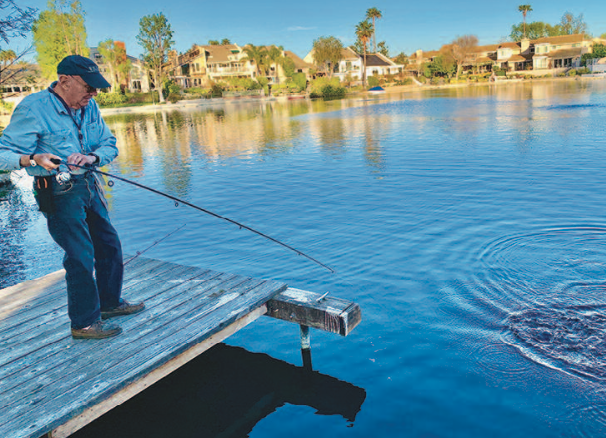
BY JON DICKENS
Bass fishing is complicated. If you’re like most bass anglers, you’ve probably got at least a dozen different styles of lures in your tackle box, with a dozen or more variations and colors for each of those styles. Which is the right one to throw in shallow water? In deeper water? Around rocks, docks, weeds, etc.? How do you work the bait? Should your retrieve be slow, fast, lift and drop, steady, erratic?
Phew! Too much work. If your brain goes into overdrive trying to figure out what to throw, you’re not alone. But I have a solution for you if you want to keep it simple and just cast and crank. It may not be the sexiest bait out there or appropriate for every situation, but it’s just about the easiest to throw for springtime bass and yields great catches for novices and veterans alike — the swimbait. Or more specifically, SMALL swimbaits.
We’re not talking about the big trout imitators thrown by dedicated trophy hunters, the ones that take a thousand casts to hook a big fish and cost any- where from $25 to $200. Nope, we’re focusing on the small, slender finesse swimbaits that
imitate minnow-shaped forage in the 3- to 4-inch range. These are killer baits that can catch large bass. And they don’t require a PHD in bass behavior to know how to fish them.
Chuck and wind
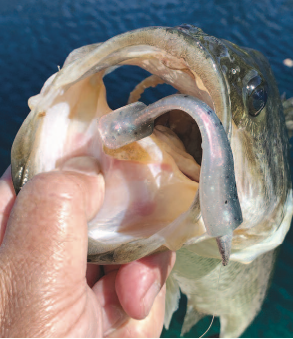
Sometimes it’s refreshing to put aside the complexities of so many different techniques and just flat out chuck and wind and make it a low stress kind of day on the water. Like any style lure presentation, you may have to experiment with retrieve speeds, but for the most part, this is a pretty easy way to fish. Small swimbaits work in big reservoirs to small ponds and make an easy meal for a hungry
or provoked bass. Sometimes they’ll smack the heck out of it and sometimes they’ll follow it for a while before they strike. But because the baits are relatively small, you don’t get as many “short bites” as you do with larger baits and your hook-up ratio is likely to go up.
While smaller swimbaits are a great reaction bait, especially for pre-spawn bass looking to bulk up before bedtime, more bites will come as a result of a bass following your bait. Once you get dialed in, you’ll be able to “feel” when a bite is coming from a following bass. The rhythm of the bait will feel different when a bass is closing in
on it. It’s a subtle difference caused by the change in water displacement. Some anglers will speed their retrieve up a bit or twitch the rod tip slightly, but I find a steady retrieve speed will generally get you more bites. Let the bait do the work for you.
Slender body with a big booty
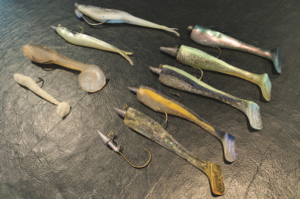
Every manufacturer has variations in swimbait shape, but the most consistent producers are those with a v-shaped body as you look down on it. They typically track straighter on the retrieve without too much rolling. The thickness of the bait, how it tapers, the type plastic used and the size and shape of the bootie — or boot tail — all affect how the baits swim. One thing you might look at is the flange around the boot tail. Ideally it should have a sharp, crisp edge to cut through the water cleanly and give the bait more built-in action. Some baits have a faster, tighter wobble and some have more side-to-side kick. If one style isn’t working, try another. But for the most part, the differences are subtle.
Personally, I put more stock in durability than anything else. Some baits swim great and get bit well, like the Keitech series, but they don’t hold up too well because they’re so soft. It’s a trade-off. Are you okay with one-and-done baits, or do you want baits that last? Many would say they’ll take a one-and-done if it’s getting bit and put up with changing their baits frequently. My counter to that: if the fish are on the chew, I don’t want to be out of the water changing my bait and miss a small window of opportunity. If that happens multiple times a day, then you’re missing out on hooking a lot more fish. I’ve found that more durable baits, like those made by Big Hammer, MC and Z-Man get bit well, and they last. Plus they’re inexpensive, with the 3- to 4-inch sizes costing less than a buck apiece. Just my two cents worth.
Swimbait jigheads
There are several considerations in deciding what kind of jig head to put your swimbait on. First is depth. Many bass anglers rely on a round, ball-shaped jighead, especially for shallow water or suspended bass. In deeper water, a heavier football head comes into play when you want your bait bumping structure near the bottom.
But because I tend to fish shallow lakes, I prefer a third option: the darthead jig. Its pointed head cuts through the water easily, doesn’t inhibit the action of the swimbait, and it’s easily fished around structure and over the top of grass. In 2 to 10 feet of water, I like a 1/8- ounce darthead jig for its versatility. If you meter suspended fish or fish on the bottom, vary your retrieve speed to stay in the zone. It’s good in open water as well as around the rocks, wood and other structure you’ll encounter. A telltale sign that you’ve been bouncing off rocky bottoms is evidenced by a dart- head whose nose becomes slightly upturned from hitting the structure. A good sign if the fish are in that structure.
Another reason I like dartheads is because they typically have a thinner wire hook that easily goes through the plastic swimbait and has just the right amount of hook exposed for good hooksets. The thinner wire hook penetrates well and never seems to straighten out or cause you to lose a bass, but is helpful when snagged because putting pressure on it can cause a slight bend in the gap of the hook that will often free you up and prevent losing the bait.
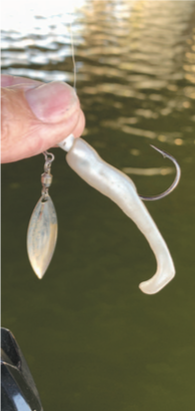
When fishing over grass, around thick vegetation or skipping under boat docks, a belly or keel-weighted hook is a good way to go. It keeps the hook buried in the bait and gives you a weedless presentation when going through and over the snaggy stuff. However, if you do snag the grass, you’re likely to trigger bites when you rip the bait out of it, so stay alert. Another option in these situations is using a weightless swimbait threaded onto a Texas-rigged wide gap hook. If the bait is heavy enough to cast without weight, it can be deadly in extreme shallows, when skipped under boat docks, fished tight to the shoreline or over beds.
The last category of jigheads to consider are underspins like small Warbait and Coolbaits jigs that add a flashing blade to at- tract the fish. I like using them when I know there are fish tight to the bottom, and sloooowly bounce them over the rocks, barely turning the handle of the reel. There are lots of jighead options out there but the goal here is to keep it simple. If I had to pick just one, it would be the darthead.
One of the most important things in swimbait fishing, however, is positioning the bait properly when threading it on the hook of whatever style jighead you use. If it isn’t centered properly and straight, it will negatively affect the way the bait swims. Before threading it on, align the bait next to the jighead and note where the bend of the hook should be positioned to penetrate the plastic bait. Some make a mark there, until hitting the right spot be- comes second nature.
Water clarity and bait color
Boot-tailed swimbaits have a fairly tight wobble and don’t give off the kind of vibration that bass pick up with their lateral line like they do with a spinnerbait or Chatterbait. Elite Series bass pro Mark Menendez says, “These swimbaits are a very sight-oriented presentation. If the bass can’t see them, they probably won’t even know they’re in the vicinity. If you don’t have at least 18 to 24 inches of water clarity, you’re probably better off choosing another type of lure.”
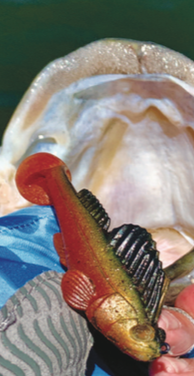
If the water is stained or dingy, dark-colored swimbaits or those with a darker back and light contrasting belly can be a good choice. Sometimes switch- ing to something different like a split-tail swimbait or even a Megabass Dark Sleeper will be a difference maker.
In shallow, clear water, go with lighter-colored baits. Anything with a green or blue/green back works, and those embed- ded with sparkly glitter give an added dimension. Overall, try to match the hatch. There are days when one color outperforms the rest, but just like jig fishing for surface fish in saltwater, I think color is overrated not as important as action.
Finesse swimbait tackle
When scaling down to 3- to 4-inch finesse baits, spinning tackle is the way to go. My standard rig is a 7-foot medium-heavy rod with a spinning reel loaded with 15-pound braid and an 8-pound fluorocarbon leader. This will give you maximum casting distance, which is important in clear water to reduce spooking the fish. It also allows the bass more time to follow your swimbait before they decide to eat it.
When you do get bit, let the rod load up and just reel faster to set the hook, instead of swinging for the fences. With braided line, you don’t have to worry about the stretch factor if you hook up way out there like you do with monofilament.
So the next time you’re on the water this spring and you’re looking for a low-stress easy way to fish or have a newbie with you, break out the spinning gear and those little finesse swimbaits. They just might make your day.




